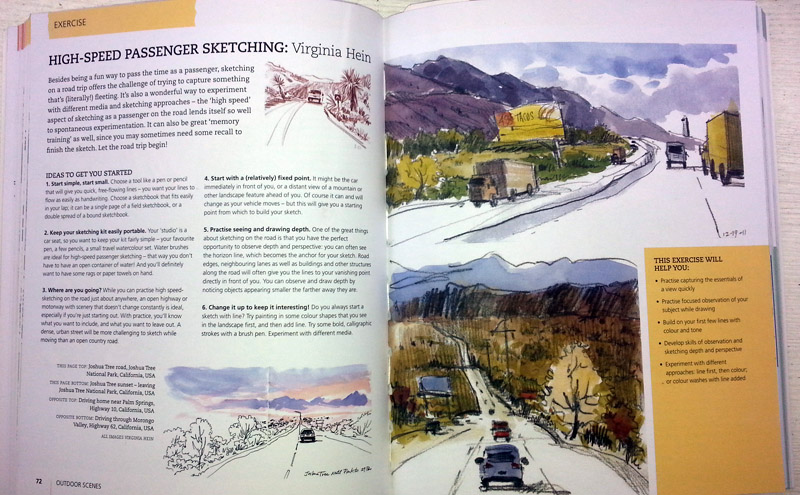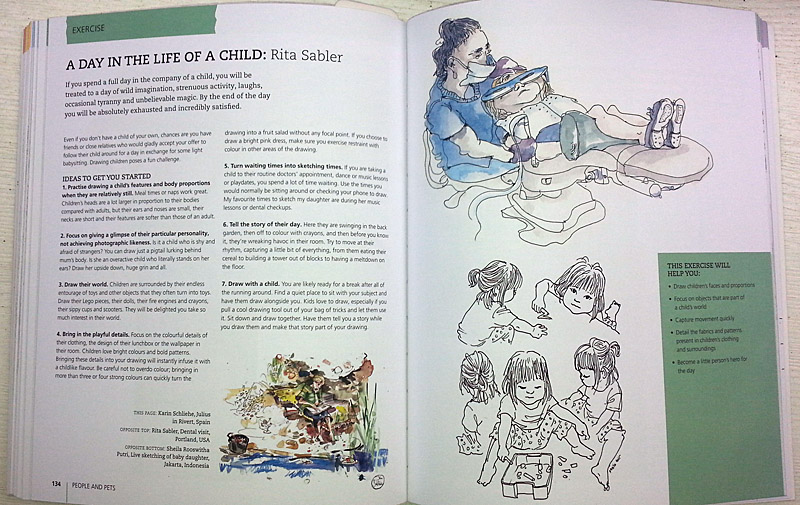Before I talk about Pete Scully’s new book, Creative Sketching Workshop: Inspiration, Tips, and Exercises for Sketching on the Move, I’ve got to confess that I am biased. If Pete released an illustrated phone book, I’d buy it. When I got started sketching, his sketches were some of the first that caught my eye. I love his precision. I love his choice of subjects (he got me sketching fire hydrants). I love that he’s a generalist sketcher who is at home sketching Lego characters as he is when sketching urban scenes.
 Though a clear violation of Pete’s copyright, I’m opening this review with his sketch of his new book; I hope he doesn’t mind. The one on the left is the US version; the one on the right is the UK version. I bought the UK version because it was available when I ordered; the US version hadn’t been released yet.
Though a clear violation of Pete’s copyright, I’m opening this review with his sketch of his new book; I hope he doesn’t mind. The one on the left is the US version; the one on the right is the UK version. I bought the UK version because it was available when I ordered; the US version hadn’t been released yet.
My love of Pete’s work aside, do we really need another sketching book? I find that a funny question to pose because when I got into sketching, only four years ago, there was almost nothing available on location sketching, urban sketching, or even a general acknowledgement that people sketched for any purpose other than as note-taking for paintings. But, we’re experiencing a veritable explosion of interest in sketching, particularly location sketching and it’s absolutely wonderful.
Recent releases seem to fit into three loose categories.
- Rah-rah motivation books: so you want to sketch but don’t think you can, and/or if you can’t figure out what to draw, let us give you a list. The extreme of this are the books that have a bunch of blank pages except for a ‘draw x’ written in one corner.
- Books on sketching techniques. These can be about pen and ink, pencil, paint, and these days may place most emphasis on “urban sketching” as that’s the buzz phrase of our time.
- Then there are books that are mostly picture books, and more than anything are just a compilation of sketches from a particular artist.
All of these have value to someone. Most are directed at the flood of new sketchers among us. As a book nut, I’ve bought most of them and I gotta say that there’s a lot of redundancy within the ranks but I’ve gotten something from each and every one of them. To be honest, I didn’t expect much from Pete’s book in spite of it coming from Pete. I was wrong.
Pete’s book has some of all of the above types of content, but it’s the approach that makes it unique and much more instructional content than I expected. The book reflects his generalist inclination when it comes to sketching. He brought together a dozen artists besides himself and together they have produced a series of “workshops” on topics that run the gamut from doing portraits on location to drawing abandoned locations. Pete’s fond of documenting his son’s growth and he uses this to demonstrate the virtues of drawing series of sketches, showing us sketches of his son’s shoes, from when he was a baby to his current running shoes. I still favor his fire hydrant series myself but wish I had a similar series of my daughter’s shoes.
Each sketching subject workshop is initiated with half a dozen “Ideas to get you started” that serve as an outline for the rest of the workshop but also as a platform for the artist to provide practical advice for sketching their particular subject. Some of this advice is priceless. All of it is good.
The rest of each chapter consists of several pages of graphic examples and associated text that directs the reader towards the specifics of the sketch, why the artist has done what’s been done, and sometimes with extra advice on the vagaries of doing such sketches on location.
In short, this is a book you’ve got to read and study. But yeah, you’ll want to flip through it, just looking at the pictures like I did when I got it. The eye-candy is sweet. But this review comes several days after receiving the book because I wanted to read all of it before writing.
Because of the artists assembled here, this book provides considerable variation in sketching styles and approaches. Thus, even without the words, there’s a lot to study here and this book will sit by my bed for a while as I love staring at sketches, trying to understand what the artist was thinking and how they solved this or that problem. I very much recommend Creative Sketching Workshop to anyone who sketches on location or wants to learn the approaches of people who do.





Thank you for sharing this interesting book.